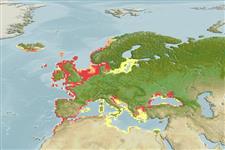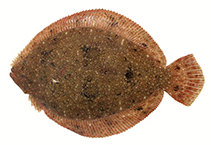Scophthalmus rhombus (Linnaeus, 1758)
Brill
Add your observation in Fish Watcher
| Native range | All suitable habitat | Point map | Year 2050 |

|
| This map was computer-generated and has not yet been reviewed. |
| Scophthalmus rhombus AquaMaps Data sources: GBIF OBIS |
Upload your photos and videos
Pictures | Google imageScophthalmus rhombus
Female picture by Giragosov, V.
Pictures | Google imageScophthalmus rhombus
Female picture by Giragosov, V.
Denmark country information
Common names:
Europæisk slethvarre, Slethvarre
Occurrence: native
Salinity: marine
Abundance: fairly common (chances are about 50%) | Ref: Winkler, H.M., K. Skora, R. Repecka, M. Ploks, A. Neelov, L. Urho, A. Gushin and H. Jespersen, 2000
Importance: minor commercial | Ref:
Aquaculture: | Ref:
Regulations: protected | Ref:
Uses: no uses
Comments: Occurs in all the waters around Denmark (Ref. 6302). Minimum size limit in TL: 30 cm. Protected in some parts of the Baltic Sea and parts of the Belts in the Period: 1. June - 31. July (Ref. 10963). Also Ref. 9900.
National Checklist:
Country Information: https://www.cia.gov/library/publications/resources/the-world-factbook/geos/da.html
National Fisheries Authority:
Occurrences: Occurrences Point map
Main Ref: Nielsen, J.G., 1986
National Database:
Occurrence: native
Salinity: marine
Abundance: fairly common (chances are about 50%) | Ref: Winkler, H.M., K. Skora, R. Repecka, M. Ploks, A. Neelov, L. Urho, A. Gushin and H. Jespersen, 2000
Importance: minor commercial | Ref:
Aquaculture: | Ref:
Regulations: protected | Ref:
Uses: no uses
Comments: Occurs in all the waters around Denmark (Ref. 6302). Minimum size limit in TL: 30 cm. Protected in some parts of the Baltic Sea and parts of the Belts in the Period: 1. June - 31. July (Ref. 10963). Also Ref. 9900.
National Checklist:
Country Information: https://www.cia.gov/library/publications/resources/the-world-factbook/geos/da.html
National Fisheries Authority:
Occurrences: Occurrences Point map
Main Ref: Nielsen, J.G., 1986
National Database:
Common names from other countries
Classification / Names Nombres comunes | Sinónimos | Catalog of Fishes(Género, Especie) | ITIS | CoL | WoRMS | Cloffa
> Pleuronectiformes (Flatfishes) > Scophthalmidae (Turbots)
Etymology: Scophthalmus: Greek, skopelos = a lantern fish + Greek, ophthalmos = eyes (Ref. 45335).
More on author: Linnaeus.
Etymology: Scophthalmus: Greek, skopelos = a lantern fish + Greek, ophthalmos = eyes (Ref. 45335).
More on author: Linnaeus.
Environment: milieu / climate zone / depth range / distribution range Ecología
marino demersal; oceanodromo (Ref. 51243); rango de profundidad 5 - 50 m (Ref. 6302). Temperate; 64°N - 26°N, 24°W - 42°E
Distribución Países | Áreas FAO | Ecosistemas | Ocurrencias, apariciones | Point map | Introducciones | Faunafri
Eastern Atlantic: 68°N to Morocco. Reported from Iceland (Ref. 12462). Also known throughout the Mediterranean and Black Sea.
Length at first maturity / Tamaño / Peso / Age
Maturity: Lm 37.0, range 33 - 41 cm
Max length : 75.0 cm TL macho / no sexado; (Ref. 35388); common length : 30.0 cm TL macho / no sexado; (Ref. 3397); peso máximo publicado: 8.0 kg (Ref. 35388); edad máxima reportada: 6 años (Ref. 38118)
Max length : 75.0 cm TL macho / no sexado; (Ref. 35388); common length : 30.0 cm TL macho / no sexado; (Ref. 3397); peso máximo publicado: 8.0 kg (Ref. 35388); edad máxima reportada: 6 años (Ref. 38118)
Short description Claves de identificación | Morfología | Morfometría
Thinner and more slender body. Skin with small, smooth scales, without bony tubercle. Able to change color of the eyed side, matching the bottom they rest on. Color is often olive green, with dark and light spots (Ref. 35388).
Lives on sandy or mixed bottoms; feeds on bottom-living fishes and larger crustaceans. Marketed fresh and frozen; eaten steamed, fried, broiled, boiled, microwaved and baked (Ref. 9988).
Life cycle and mating behavior Madurez | Reproducción | Puesta | Huevos | Fecundidad | Larva
Main reference
Upload your references | Referencias | Coordinador | Colaboradores
Bauchot, M.-L., 1987. Poissons osseux. p. 891-1421. In W. Fischer, M.L. Bauchot and M. Schneider (eds.) Fiches FAO d'identification pour les besoins de la pêche. (rev. 1). Méditerranée et mer Noire. Zone de pêche 37. Vol. II. Commission des Communautés Européennes and FAO, Rome. (Ref. 3397)
IUCN Red List Status (Ref. 130435: Version 2024-2)
Least Concern (LC) ; Date assessed: 10 December 2020
Threat to humans
Harmless
Human uses
Pesquerías: comercial; pesca deportiva: si
FAO(Aquaculture systems: producción; pesquerías: producción; publication : search) | FIRMS (Stock assessments) | FishSource | Sea Around Us
Más información
Trophic ecology
componentes alimenticios
Composición de la dieta
consumo de alimento
Food rations
Despredadores
componentes alimenticios
Composición de la dieta
consumo de alimento
Food rations
Despredadores
Population dynamics
Coeficiente del crecimiento para
Max. ages / sizes
Length-weight rel.
Length-length rel.
Length-frequencies
Mass conversion
Reclutamiento
Abundancia
Coeficiente del crecimiento para
Max. ages / sizes
Length-weight rel.
Length-length rel.
Length-frequencies
Mass conversion
Reclutamiento
Abundancia
Life cycle
Reproducción
Madurez
Fecundidad
Puesta
Spawning aggregations
Huevos
Egg development
Larva
Dinámica larvaria
Reproducción
Madurez
Fecundidad
Puesta
Spawning aggregations
Huevos
Egg development
Larva
Dinámica larvaria
Anatomy
Superficie branquial
Brain
Otolith
Superficie branquial
Brain
Otolith
Physiology
Body composition
Nutrients
Consumo del oxígeno
Tipo de natación
Velocidad de natación
Visual pigments
Fish sound
Diseases & Parasites
Toxicity (LC50s)
Body composition
Nutrients
Consumo del oxígeno
Tipo de natación
Velocidad de natación
Visual pigments
Fish sound
Diseases & Parasites
Toxicity (LC50s)
Human related
Aquaculture systems
Perfiles de acuicultura
Razas
Ciguatera cases
Stamps, coins, misc.
Aquaculture systems
Perfiles de acuicultura
Razas
Ciguatera cases
Stamps, coins, misc.
Herramientas
E-book | Guía de campo | Claves de identificación | Asistente para frecuencias de tallas | Herramienta de ciclo de vida | Mapa de puntos | Classification Tree
| Catch-MSY |
Special reports
Download XML
Fuentes de Internet
Aquatic Commons | BHL | Cloffa | Websites from users | Check FishWatcher | CISTI | Catalog of Fishes(Género, Especie) | DiscoverLife | DORIS | ECOTOX | Faunafri | Fishtrace | GenBank(genome, nucleotide) | GloBI | GOBASE | | Google Books | Google Scholar | Google | IGFA World Record | MitoFish | Bases de datos nacionales | Otolith Atlas of Taiwan Fishes | Acuarios públicos | PubMed | Reef Life Survey | Scirus | SeaLifeBase | Árbol de la vida | Wikipedia(Go, búsqueda) | World Records Freshwater Fishing | Expediente Zoológico
Estimates based on models
Preferred temperature (Ref. 115969): 8.4 - 19.5, mean 11.2 (based on 472 cells).
Phylogenetic diversity index (Ref. 82804): PD50 = 0.5645 [Uniqueness, from 0.5 = low to 2.0 = high].
Bayesian length-weight: a=0.01096 (0.00893 - 0.01346), b=3.01 (2.95 - 3.07), in cm Total Length, based on LWR estimates for this species (Ref. 93245).
Nivel trófico (Ref. 69278): 4.4 ±0.1 se; based on diet studies.
Resiliencia (Ref. 120179): Medio, población duplicada en un tiempo mínimo de 1.4-4.4 años (tm=-5; tmax=6).
Prior r = 0.47, 95% CL = 0.31 - 0.70, Based on 5 full stock assessments.
Fishing Vulnerability (Ref. 59153): Moderate vulnerability (36 of 100).
Climate Vulnerability (Ref. 125649): Moderate to high vulnerability (54 of 100).




